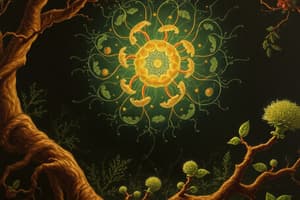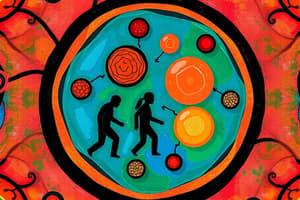Podcast
Questions and Answers
What is cell theory?
What is cell theory?
Cell theory states that all living organisms are composed of one or more cells, which are the basic units of life.
Who is credited with the development of the theory of evolution?
Who is credited with the development of the theory of evolution?
Charles Darwin
What are the three core principles of Darwin's theory of evolution?
What are the three core principles of Darwin's theory of evolution?
Common descent, gradualism, and natural selection
What process creates two identical daughter cells during cell division?
What process creates two identical daughter cells during cell division?
What controls the function of cells through proteins produced by genes?
What controls the function of cells through proteins produced by genes?
What is the significance of the cell wall in plant cells?
What is the significance of the cell wall in plant cells?
Describe the role of chloroplasts in plant cells.
Describe the role of chloroplasts in plant cells.
Explain how the Golgi apparatus contributes to plant cell function.
Explain how the Golgi apparatus contributes to plant cell function.
How does natural selection contribute to the evolution of species?
How does natural selection contribute to the evolution of species?
What is the primary function of the endoplasmic reticulum (ER) in plant cells?
What is the primary function of the endoplasmic reticulum (ER) in plant cells?
Flashcards are hidden until you start studying
Study Notes
Evolution of Life and Plant Cell Structure
The evolution of life on Earth has been a gradual process that spans billions of years. This evolution has led to the development of diverse organisms, from unicellular bacteria to multicellular plants and animals. Understanding this evolution requires knowledge of several key concepts, including cell theory, the theory of evolution, and plant cell structures.
Cell Theory
Cell theory is the fundamental concept of biology that states all living organisms are composed of one or more cells, which are the basic units of life. Cells arise from pre-existing cells during the process of mitosis, where the nucleus divides, creating two identical daughter cells. Additionally, cell theory posits that all cells contain genetic material, DNA, which controls their function through proteins produced by genes.
Theory of Evolution
The theory of evolution explains how various species have arisen over time through natural selection acting upon inherited variation. Charles Darwin is widely credited with developing the concept of natural selection, though he was not the first to propose it (Lamarck's ideas were similar). He introduced his scientific theory that this branching pattern of evolution resulted from a process that he called natural selection, in his 1859 book On the Origin of Species.
Darwin's theory of evolution emphasizes three core principles: common descent, gradualism, and natural selection:
- Common Descent: All living organisms share a common ancestry; there is not just one tree of life, but many smaller ones.
- Gradualism: Evolution occurs slowly, through small changes accumulating over vast periods of time.
- Natural Selection: Organisms vary and some traits are heritable. Over time, differences between populations can lead to different species. Those variants better suited to their environment tend to survive and reproduce more, passing on these advantageous traits to the next generation.
Plant Cell Structures
Plants are complex organisms containing a variety of specialized cells designed for specific functions within their ecosystems. Some essential plant cell components include:
- Nucleus: The control center of the cell, containing most of the genetic information.
- Mitochondria: These organelles produce ATP, the energy currency of the cell.
- Chloroplasts: They contain pigments and specialized membranes for photosynthesis, converting sunlight into chemical energy.
- Endoplasmic Reticulum (ER): This network of tubules is involved in protein synthesis, lipid synthesis, and calcium storage.
- Golgi Apparatus: It modifies, sorts, and packages proteins and lipids for transport to their destination.
- Vacuoles: These membrane-bound compartments store water, nutrients, and waste materials.
- Cell wall: This extracellular material provides mechanical support and protection.
Understanding the evolution of life and plant cell structures requires a deep exploration of these core concepts. As research continues, our knowledge of how life has evolved and the complex structures of plant cells will continue to expand.
Studying That Suits You
Use AI to generate personalized quizzes and flashcards to suit your learning preferences.




